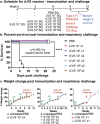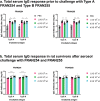The rLVS Δ capB/ iglABC vaccine provides potent protection in Fischer rats against inhalational tularemia caused by various virulent Francisella tularensis strains
- PMID: 37975637
- PMCID: PMC10760400
- DOI: 10.1080/21645515.2023.2277083
The rLVS Δ capB/ iglABC vaccine provides potent protection in Fischer rats against inhalational tularemia caused by various virulent Francisella tularensis strains
Erratum in
-
Correction.Hum Vaccin Immunother. 2024 Dec 31;20(1):2307699. doi: 10.1080/21645515.2024.2307699. Epub 2024 Jan 28. Hum Vaccin Immunother. 2024. PMID: 38282336 Free PMC article. No abstract available.
Abstract
Francisella tularensis is one of the several biothreat agents for which a licensed vaccine is needed. To ensure vaccine protection is achieved across a range of virulent F. tularensis strains, we assembled and characterized a panel of F. tularensis isolates to be utilized as challenge strains. A promising tularemia vaccine candidate is rLVS ΔcapB/iglABC (rLVS), in which the vector is the LVS strain with a deletion in the capB gene and which additionally expresses a fusion protein comprising immunodominant epitopes of proteins IglA, IglB, and IglC. Fischer rats were immunized subcutaneously 1-3 times at 3-week intervals with rLVS at various doses. The rats were exposed to a high dose of aerosolized Type A strain Schu S4 (FRAN244), a Type B strain (FRAN255), or a tick derived Type A strain (FRAN254) and monitored for survival. All rLVS vaccination regimens including a single dose of 107 CFU rLVS provided 100% protection against both Type A strains. Against the Type B strain, two doses of 107 CFU rLVS provided 100% protection, and a single dose of 107 CFU provided 87.5% protection. In contrast, all unvaccinated rats succumbed to aerosol challenge with all of the F. tularensis strains. A robust Th1-biased antibody response was induced in all vaccinated rats against all F. tularensis strains. These results demonstrate that rLVS ΔcapB/iglABC provides potent protection against inhalational challenge with either Type A or Type B F. tularensis strains and should be considered for further analysis as a future tularemia vaccine.
Keywords: Francisella tularensis; LVS (Live Vaccine Strain); aerosol challenge; animal model; rat; tularemia; vaccines.
Conflict of interest statement
No potential conflict of interest was reported by the author(s).
Figures






References
-
- Jellison WL. Tularemia in Montana. Mont Wildl. 1971:5–24. PMID: 11614973. - PubMed
Publication types
MeSH terms
Substances
Grants and funding
LinkOut - more resources
Full Text Sources
Other Literature Sources
